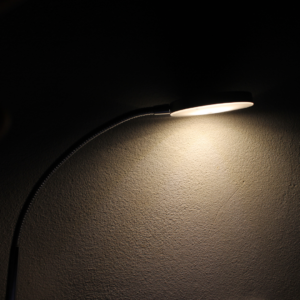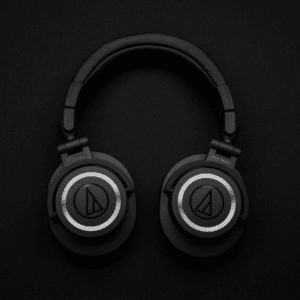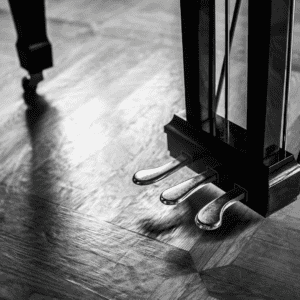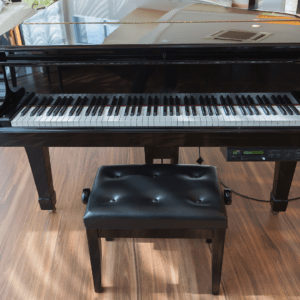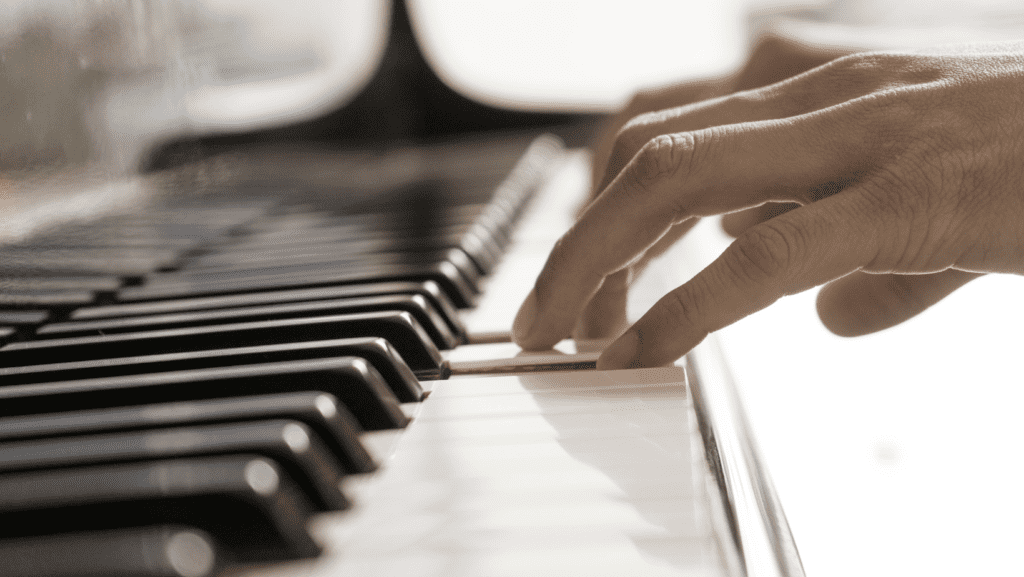
Do you dream of playing your favorite songs on piano one day? There is no doubt that you will be able to make your dream come true. The question is how much time it takes.
No one will give you an exact answer, since it depends on a lot of factors: your prior knowledge on music, what kind of instruction you’ll get and most importantly what you consider as being “good” at playing piano.
Being good at another instrument could expediate your piano learning. A lot of the music theory, rhythm and ear training are shared across instruments.
In this article, we will discuss how long it would take you to reach different milestones of piano learning, assuming you have not learnt any other music instruments.
To make it easier to understand the timeline, we will use various well-known songs or pieces as benchmark. These estimates of time are made based on the assumption that you are practicing regularly and consistently, say half an hour to one hour a day, at least 5 days a week. Remember consistent practice is the key. Practice 6 days a week at 1 hour a day will give you much better results than practice 2 days a week at 3 hours a day.
Here is a quick summary:
- 3 months into piano: Green Sleeves simplified version
- 6 months into piano: Game of thrones Theme
- 1 year into piano: Forrest Gump – Feather theme
- One and half years into piano: Gymnopedie No.1 (And many other popular pieces)
- 2 years into piano: Fur Elise (And many other famous classical pieces)
- 5+ years into piano: Moonlight Sonata 3rd movement
Note that the time listed above should be interpreted as roughly the amount of training you need before you could start to tackle the piece. You will still need to spend days of practices to actually master the piece. Generally if you take on a piece that is much more difficult than your current level, you’ll spend more time on learning it and not to a proficient level. So it is recommended that you leap ahead too much. If you have a tutor, they’ll give you the best advice on whether a piece is too easy or too difficult for you.
In the next section, let’s dive into the details of why I think these pieces are appropriate for adults with the corresponding amount of training. This is derived from my own experience and also the progress people have shared in the community.
3 months into piano: Green sleeves
Even the same song could have multiple versions. Here I’m referring to this relative simplified version of the song greensleeves. It is a lovely little piece. The left hand is basically playing out the chord as an individual note, the right hand plays the main melody which involves one note at a time. The rhythm is not too complicated. Even though it is not technically challenging, it sounds really beautiful. I think it is a great beginner piece to learn. You can find the score here.
In this early stage, it is important that you develop the right habits of playing piano, things like how to sit, how to relax your wrists and shoulders, and how to press the keys correctly. Even though you may not yet be committed to taking piano seriously, you should find a teacher to provide some guidance. Perhaps you can’t get a professional teacher yet, but just a friend who had some formal training in piano could be very helpful. It will save you a lot of time later on if you do decide to continue the journey.
6 months into piano: Game of thrones Theme easy version
A lot of people got into piano inspired by movie soundtracks. Surprisingly a lot of movie soundtracks are not that difficult to play due to the repeats in the melody and relative slow beat. This specific version of Game of thrones is quite achievable if you are practicing piano consistently for 6 months. It is a great piece to learn to entertain your friends who fans of the movie.
The left hand of this piece is made of two note chords. There are no big jumps in the left and right hand at the same time. The rhythm is quite straightforward too. If you already know the melody it will also make it easy to remember the piece. Also there is no 16th note which is another reason I would recommend this piece for someone with ~6 months experience. The 168 beats per minute marked speed could be fairly fast for beginners. You should feel free to slow down a bit. It would still sound pretty awesome.
Here is the link to the score. Really love the arrangement by lucky37. I couldn’t find the exact same version on youtube. This video I shared above is perhaps even simpler than the arrangement by lucky37.
1 year into piano: Forrest Gump – Feather theme
This is one of my favorite piano pieces. The melody is just so beautiful and calming. Every time I play it, I feel relaxed and it reminds me there are so many precious things in life that I want to live every moment full. Being able to play this song is like a dream come true moment to me. I’m sure some pieces are of special meaning to you too.
So don’t rush to learn your dream song. Don’t start to play it before your techniques are ready. You may still be able to learn it but it will take way too long. If it takes too long to learn, your passion wears out. Also you’ll not be able to get all of the subtleties in the music, basically the musicality out of the piece, if your techniques are not ready.
Going back to the Feather theme, this song does have a few challenges. First it is in A major, this means you’ll have to hit a lot of black keys. You need to get comfortable with it. Second, the left hand has this off beat rhythm that you may need to get used to. Third, you need to learn how to pedal before you can play this song. Correct pedalling is absolutely necessary for this piece. Lastly, the right hand has a lot of melody lines consisting of sixth notes. You need to be able to play them smoothly in a legato way. You also need to learn to control the amount of pressure of each finger so that the melody line stands out.
Don’t let all of the challenges above scare you. With one year of practice, you should be able to expose yourselves to a few different keys and learn how to pedaling. You’ve probably learned to play multiple notes at the same time in your hand in pieces here and there. I’m confident that you should be able to play this piece at the one year’s mark. Here is the link of the music score for Forrest Gump – Feather theme.
One and half years: Gymnopedie No.1 (And many other popular pieces)
This is a huge milestone to hit and now you may have developed sufficient techniques to take on a lot of the popular songs. You’re a late beginner to an intermediate player. It’s like learning a new language and now suddenly you can read most of the best sellers on the bookshelf. Even thought there are probably a lot of pieces that are too hard for you, this is the stage that you start to have a lot of fun.
After you get to this stage, you shouldn’t only focus on “playing” per se. It will probably bring you much more fun if you could also up level your sight reading abilities so that you can learn new pieces faster. Or to invest in “playing by ear”, so you can play the songs that you’ve heard on the radio.
Here are a few great pieces for players at this stage:
Gymnopedie No.1 [Sheet music]
The chords in Gymnopedie could get complicated as it is no longer simple major or minor chords. The big jumps in the left hand also adds challenges to this piece. It is a relatively slow piece, so playing it out in a flowy and smooth manner is important to convey the emotion.
River flows in you [Sheet Music]
There are a lot of 16th notes in the right hand, which requires some dexterity of the right hand. Before you try this piece, you probably need to practice your scale till you can play it at 90 beats per second in a steady pace.
Canon in D [Sheet Music]
Who would not love Canon in D? I have heard it in so many times in weddings and movies. I just never get tired of it. There are many different versions of it. I love this version arranged by lemontart. It is not too difficult and is quite accessible even by people who only have 1 to 2 years of experience. As you advance your piano techniques in the future, you can try out more challenging versions.
2 years: Fur Elise (And many other famous classical pieces)
In the analogy of comparing music to food, classical music is like vegetables and meats, popular music is like desserts. You probably can’t eat dessert all the time and it is healthy for music developments to play classical pieces at certain points. Well, to be honest, there isn’t any real negative impact of just eating desserts (playing popular music) in this case, it is more of a personal preference. Also the boundary between pop music and classical is blurred. What we considered as classical music today were considered as popular music for people at that time.
To get to this stage, you almost surely need some professional guidance to further advance your piano playing skills. There are so many nuances and subtleties in the playing that you probably won’t get it right without a teacher.
Assuming you have been trained for 2 years with an intention to play classical pieces on piano, you may be able to take on some of these very famous pieces:
Fur Elise
Chopin Nocturne Op9 No2
Moonlight Sonata 1st movement
5+ years Moonlight Sonata 3rd movement
After I played Moonlight Sonata 1st Movement, I was curious what the 3rd movement sounded like. And I have to say, it is absolutely astounding and gorgeous. This kind of piece probably marks the ceiling of what a amateur player could get. I once read a reddit discussion on “if a person is trapped in a room for one month and all they have is a piano, can they learn this piece?”. It is quite interesting mental experiment to go through. The answer was a no for all replies. Most people say if you have not taken 5-10 years of proper piano training, you should not even try to play it. This is definitely one of the dream pieces.
Why is it important to set the expectation on how long it would take to learn piano?
In a nutshell, setting up the right expectation on time commitment will increase your chance of success in learning the piece you like.
- Setting a clear goal motivates you. It is encouraging to see how much progress you could make in a few months or a few years. Men often underestimate how much they can achieve in years and overestimate how much they can achieve in months. This is exactly true for piano learning.
- Make a better plan on allocating practice time. A lot of people underestimate how much time it would take to learn piano. Therefore, they don’t schedule enough time to practice, especially for adults. You can’t learn piano out of an impulse. You need persistence. There are so many things popping up from our life randomly, distracting you from your practice. You need to intentionally protect your practicing time to make it happen. Half an hour a day on most days a week, for several months, is a good starting point. Learning piano is more of a marathon than a sprint.
- Reduce self doubts when hitting a bottleneck in practicing. I have moments when I got through a piece smoothly and quickly and though I was a genius. But more often, I have moments that I just can’t seem to get through a passage in a piece, and deeply question whether I lack the talent to learn piano. Especially nowadays, on youtube or other social media, you may see people post about unbelievable amazing one year piano progress and you may feel your progress is way below the average. The truth is that a lot of progress videos may not be from real beginners. Don’t be misled by these videos. What I listed above is a more realistic progress bar.
How to learn piano faster?
I have definitely spent a considerable amount of time researching this, especially as I practice boring hand dexterity drills (yes, Hanon, I’m pointing to you). From time to time, you may question whether the practice you’re doing now is actually a waste of time. However, one thing to bear in mind is that there is no shortcut in learning piano. The best shortcut you could have is to work with a great teacher. Have an open conversation with your piano teacher on what your goal is and what types of pieces or performances you want to get to. This will help the teacher to prioritize the learnings.

